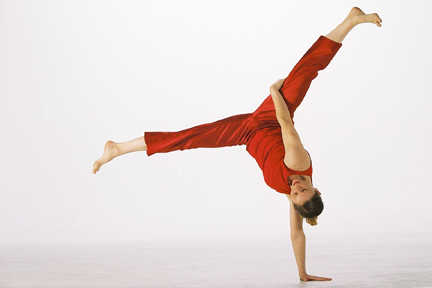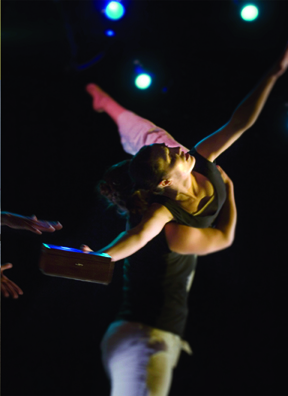San Francisco Letter No. 12
Migrations
Marielle Amrhein, Kelly Kemp, Paco Gomes & Dancers
ODC Theater, San Francisco
July 1, 2006
RHJ/Pronounced Ridge
Robert Henry Johnson
Dance Mission Theater, San Francisco
July 7, 2006
by Rita Felciano
copyright ©2006 by Rita Felciano
 “Migrations” is the second stage of ODC Theater’s graduated workshop program for post-college choreographers. Three at a time, they are given that most precious commodity for all dance makers: space, time and a supportive environment. The choreographers in “Migrations” are no longer rank beginners; in the current group, two have distinct choreographic personlities while the third one is still floundering, putting too much material into too little structure.
“Migrations” is the second stage of ODC Theater’s graduated workshop program for post-college choreographers. Three at a time, they are given that most precious commodity for all dance makers: space, time and a supportive environment. The choreographers in “Migrations” are no longer rank beginners; in the current group, two have distinct choreographic personlities while the third one is still floundering, putting too much material into too little structure.
Kelly Kemp makes dances that are fast, super kinetic and fragmented; they shoot through quirky athletic phrases with a deadpan sense of humor. My companion that night described them as “rhythmic pantomime”. Even the non-narrative and excellently performed “squint,” sparkled with comedic moments when Kemp surprised herself at having plopped into cross-legged squat or that a crawl had ended in a handstand. Fast-paced, tightly set to a Mickey Hart score, the piece intriguingly fused gymnastic with dance.
With “Prepositional Phrases” and “Scintillating Conversation” Kemp presented two episodes from a larger piece to be premiered next year. Assembling her own scores, she worked with manipulating texts — sped up, looped, overlapping — which she then wove into pop music selections. The results, engineered by Hal Hutchinson, functioned as strong percussive soundboards; they also suggested a note of frantic absurdity. The first piece of writing consisted of the elaborate disclaimers and modifiers in a legal contract. The second was based on someone’s complaint about politics in the pop music world. As disparate as they were, both texts seemed to be about jockeying for position and the mental games people play with each other in order not to be outwitted.
The choreography consisted of a volatile mix of fragmented phrases and gestures; Kemp juggled them aloft as if in a complex game of highspeed volley ball. Despite their fabulously elegant and individualized black and white pants, skirts and jackets, the dancers had a cartoonish goofiness about them. They plopped to the floor, stared at us or started racing. One of them tried to slap her own face; the gesture sent someone else’s head reeling. In “Scintillating” a dancer for the longest time sat inert mid-stage, oblivious to the activities around her. None of the moves seemed motivated but pulled out from a grab bag. Yet the sections held together because, somehow, the stupefied and the frenzied can cohabit.
“Prepositional” is a trio; “Scintillating,” a quintet. At this point the choreography for the two sections looked very similar, maybe too much so. Still Kemp has an eccentric imagination; she is someone to be watched.
 Paco Gomes, who presented three pieces, also has a good grip on what he wants. He likes parables and works with props and metaphors on power. “Two Minutes before a Slap in the Face” was a smartly timed, compact duet for Elizebeth Randall and Jeni Leary in which the two dancers’ hug-and-kiss relationship escalated into a near-fist fight in a matter of seconds. The whole thing involved one of them “stealing” the clothes of the other’s back. With razor sharp comedic timing in a quasi-slap stick manner, the piece also rode a dark undercurrent.
Paco Gomes, who presented three pieces, also has a good grip on what he wants. He likes parables and works with props and metaphors on power. “Two Minutes before a Slap in the Face” was a smartly timed, compact duet for Elizebeth Randall and Jeni Leary in which the two dancers’ hug-and-kiss relationship escalated into a near-fist fight in a matter of seconds. The whole thing involved one of them “stealing” the clothes of the other’s back. With razor sharp comedic timing in a quasi-slap stick manner, the piece also rode a dark undercurrent.
The conflict in the two-part Pride” involved Travis Rowland’s long red scarf which was coveted and passed around by four women (Randall, Leary, Rachel Halladay-Sullivan). The tension resolved itsel when each of the dancers brought a scarf of her own, and the choreography began to flow into communal play. Entered Randall, the woman in black, without a scarf; she ended up with the prized red, one slung around her neck like snake.
In part two, the dancers moved around a series of pedestals on which Randall progressed, her foot never touching the ground again. She sailed across space on the back of her colleagues, stepped into the air and found a helping hand or a just-in-time platform. This section was full of surprises and unexpected twists and turns. Here Gomes excellently contrasted Randall’s dainty and dreamlike steps with the group’s tasks and their attempts a maintaining an independent ebb and flow that lapped at the edges of the stage like waves on the beach. Randall was the island in a sea.
“Think About It”, in which Gomes took on the myth of Pandora, was a disappointment. He placed a small jewel box in the center of a group of urchin dancers — his students from SF State University — and designed a series of circular unisons for them. Four musicians performed the minimalist score; Rowland served as a portentous narrator, warning us about how easily evil is released. Though well performed by these young dancers, Gomes’ approach was so overtly didactic and heavy-handed that it made you wonder about the rationale behind the piece.
Though Marielle Amrhein’s four-part “Tales Told in the Red” was interminable, unfocused and disjointed, it looked as if she were trying to develop a narrative structure in which disparate episodes could grow out of each other organically, maybe in a spiral pattern, the way a crab’s shell grows. Even though the piece needs a lot of work, it had a few nicely choreographed moments: a duet between the Red Haired Girl and the Woman in the Cave; a live dancer with a video partner, and flingy what looked like improvisations in a barn and a courtyard, also on video.
I have watched Robert Henry Johnson perform for a good ten years, always wondering whether he would ever find his groove. Johnson is a beautiful dancer, gifted with natural fluidity and exquisitely tapered limbs. His performances exhibit velvety elegance, intensity and a good deal of showmanship. Trained in modern, jazz and at SFB, he never became a ballet dancer though for a time he did perform with Munich Ballet on the recommendation of William Forsythe. That’s where he also choreographed one his best pieces. He has said that he didn’t have the right body for ballet — he is slight of built — and that he would not fit into what still are hierarchical structures.
In the nineties, Johnson had his own company, choreographing mostly small pieces for it. The work often looked promising, sometimes also derivative. I felt at the time that he relied too much on his natural facility and that he needed to develop some craft and a sense for structure. But always when he took to the stage himself, you couldn’t take your eyes off him. Now in his thirties, Johnson still moves with grace and the self-confidence that comes from a dancer’s ease with his own body.
Johnson grew up in San Francisco’s Western Addition, the city’s largely African American neighborhood, and participated in local theater from the time he was a toddler (His mother was a cabaret singer and actor). He has written plays that have been produced. I remember a reading of one of them at the Mill Valley Playwrights Festival some years ago. It was intriguing, but also showed influences from everybody from Shakespeare to David Mamet.
In “RJJ/Pronounced Ridge”, attended by a minuscule audience, Johnson presented an evening of solos. In the 1998 “Zulu Songs” to Miriam Makeba and traditional South African Songs,” and the 2001 “Letters to Jesus”, to among others Sarah Brightman’s “Pie Jesu”, Johnson again proved himself a mesmerizing performer who makes slight material look better than it is.
The program’s centerpiece was “The Othello Papers,” first work shopped at the 2005 Black Choreographers Festival. Johnson called the current performance a preview and acknowledged that the piece needs to be refined and edited. Still, “Othello” looked like his best work years.
The premise is a gathering of Shakespeare ’s black characters — Othello, Caliban and Cleopatra — with the intent of protesting their isolation within the plays. Johnson, a good actor, played all three characters who spoke in Shakespearean and a number of contemporary voices and dialects. In typically post-modern fashion, Johnson skipped around periods, styles and perspectives; the writing was rich and witty. “Othello” is potentially an excellent vehicle for this dancer turned playwright and a funny biting monodrama. Even though this is still an unruly vehicle, Johnson rode it with skill and panache. He just might finally have found his groove.
Volume 4, No. 26
July 10, 2006
copyright ©2006 Rita Felciano
www.danceviewtimes.com